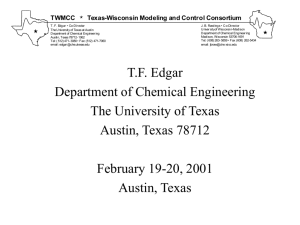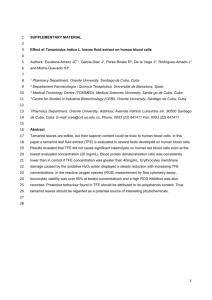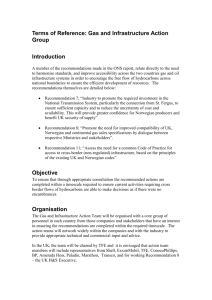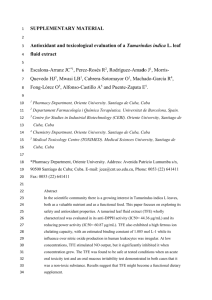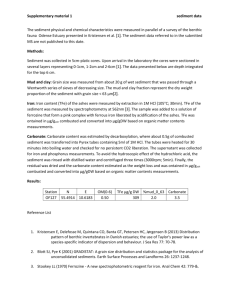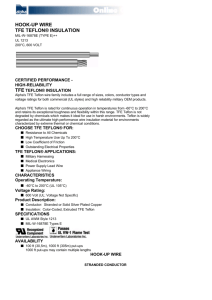Trifluoroethanol
advertisement
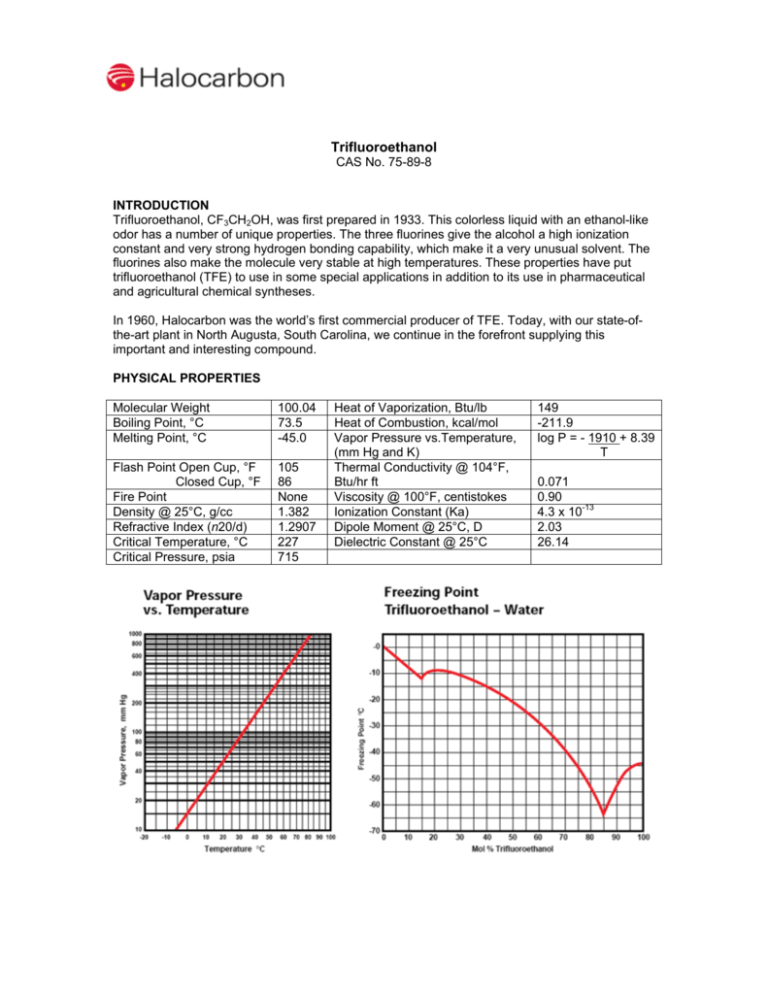
Trifluoroethanol CAS No. 75-89-8 INTRODUCTION Trifluoroethanol, CF3CH2OH, was first prepared in 1933. This colorless liquid with an ethanol-like odor has a number of unique properties. The three fluorines give the alcohol a high ionization constant and very strong hydrogen bonding capability, which make it a very unusual solvent. The fluorines also make the molecule very stable at high temperatures. These properties have put trifluoroethanol (TFE) to use in some special applications in addition to its use in pharmaceutical and agricultural chemical syntheses. In 1960, Halocarbon was the world’s first commercial producer of TFE. Today, with our state-ofthe-art plant in North Augusta, South Carolina, we continue in the forefront supplying this important and interesting compound. PHYSICAL PROPERTIES Molecular Weight Boiling Point, °C Melting Point, °C 100.04 73.5 -45.0 Flash Point Open Cup, °F Closed Cup, °F Fire Point Density @ 25°C, g/cc Refractive Index (n20/d) Critical Temperature, °C Critical Pressure, psia 105 86 None 1.382 1.2907 227 715 Heat of Vaporization, Btu/lb Heat of Combustion, kcal/mol Vapor Pressure vs.Temperature, (mm Hg and K) Thermal Conductivity @ 104°F, Btu/hr ft Viscosity @ 100°F, centistokes Ionization Constant (Ka) Dipole Moment @ 25°C, D Dielectric Constant @ 25°C 149 -211.9 log P = - 1910 + 8.39 T 0.071 0.90 4.3 x 10-13 2.03 26.14 CHEMISTRY The presence of the three fluorines in the molecule make TFE resemble the phenols more than ordinary alcohols, but it does undergo reactions typical of both. Some typical reactions of TFE are: An example from the recent patent literature is shown below. Process for preparing a trifluoroethoxy substituted benzoic acid US 6849762, 2005, Merck Patent Gmbh CO 2H OCH 2CF 3 CO 2H Cl t-BuOK, THF + Br CF 3CH 2OH CuBr, ∆ F3CH 2CO SOLUBILITIES TFE is completely miscible with water, alcohols, ketones, esters, ethers and other oxygen containing solvents. TFE is miscible with lower aliphatic and aromatic hydrocarbons, but not with higher ones. Carbon tetrachloride is only slightly miscible with TFE but chloroform and methyl chloroform are completely miscible. An unusual property of TFE is its ability to dissolve nylons at room temperature. Unlike nylon solutions in strong acids, the nylons can be recovered unchanged from these solutions. Concentrations of 3 to 10% may be made from common nylons at room temperature and metastable solutions can be made from more concentrated hot solutions upon cooling. These supersaturated solutions may remain clear for hours or even days at room temperature, serving as a convenient source of fluid nylon. Nylon is much less soluble in TFE containing hydrogen bonding liquids such as water and other alcohols. If done carefully, the addition of water to a nylon solution can be used for the stepwise determination of the molecular weight distribution of the polymer because the higher molecular weight polymers precipitate at lower water concentrations. Polymer solubility in TFE extends to oxygen containing amorphous polymers. Polymethacrylates, polyvinylacetate, cellulose acetate and many others are extremely soluble. However, the more crystalline polymers such as the polyaldehydes, polycarbonates and aromatic polyesters are insoluble. The aliphatic polymers are also insoluble. Common gases have solubility in TFE similar to their solubility in water. Nitrogen is soluble to the extent of 0.06 mL of gas per mL of liquid at 27 °C. For oxygen the value is 0.13 and for CO2 the value is 1.8. Inorganic salts are slightly soluble in TFE containing 0.2% water but are two to three times more soluble in TFE containing 5% water. The combination of TFE and water is convenient for organic ionic reactions and conductometric titrations. HANDLING AND SAFETY Toxicity TFE is toxic in rats when ingested orally (acute oral LD50: 240 mg/Kg). It causes severe eye damage similar to isopropyl alcohol and toluene. Special precautions must be taken when handling TFE. Subchronic inhalation exposure (150 ppm TFE for 6 hours per day, 5 days per week for 4 weeks) of male rats caused testicular depression leading to infertility lasting for at least 5 weeks after exposure. Similar exposure to 10 ppm had no effect and exposure to 50 ppm had a transient effect. While the significance of these observations for human safety is unknown, it is recommended that the concentration of TFE vapor in the atmosphere be kept below 5 ppm. A Material Safety Data Sheet providing safety and toxicity information for TFE will be furnished upon request. The information given here is intended for general reference only. Flammability TFE has flash points of 86°F (Pensky Martin Closed Cup) and 105 °F (Cleveland Open Cup). It is classified as a flammable liquid according to U.S. DOT regulations. However, it will not sustain its own flame because of its low heat of combustion and therefore has no fire point. Materials of Construction TFE does not present any special corrosion problems with common metals and can be handled in carbon steel. Packaging TFE is available from Halocarbon in one gallon cans, 55 pound carboys and 600 pound drums. Larger containers can be available upon request. APPLICATIONS Pharmaceutical Uses TFE is the major raw material for three inhalation anesthetics: isoflurane, CF3CClHOCF2H; desflurane, CF3CFHOCF2H; and fluroxene, CF3CH2OCH=CH2. While fluroxene is no longer used, it was the first low flammability anesthetic used to replace ether. Both isoflurane and desflurane are currently in wide use. Solvent for Nylon The solubility of nylons in TFE is used to join matching surfaces of solid nylon parts. If both surfaces are wetted with TFE and then fitted together, a permanent joint will be made. This technique is used commercially to manufacture pollution control valves for automobiles. TFE’s nylon solubility is also used to make nonfraying ends for nylon rope and solutions for quality control of nylon production. Nylon solutions in TFE can be used as vehicles for adhesives, pigments, metal powders or dyes. These mixtures yield nylon-toughened adhesives or deposit tough surface coatings. Working Fluid for Heat Engines Because of a unique combination of physical and thermodynamic properties, mixtures of TFE and water (sold by Halocarbon as Fluorinols®) can be used as working fluids for Rankine cycle heat engines. The thermal efficiency of a cycle using Fluorinols is substantially higher than the equivalent steam cycle at typical waste heat temperatures. Fluorinols also have desirable turbine expansion characteristics. Other properties of Fluorinols that make them good working fluids are thermal stability, low freezing point, no fire point and compatibility with common metals, elastomers and lubricants. Other Uses The trifluoroethoxy group in place of the ethoxy group in a dye produces a different color. TFE is also useful as a solvent to increase the quantum yields of fluorescing dyes in lasers. TFE-water mixtures are solvents for both salts and organic molecules. These materials can be brought together in solutions to probe the mechanisms of reactions. TFE’s combination of low nucleophilicity, basicity and higher ionizing power than alcohols like methanol and ethanol makes it especially useful for such studies. The low specific conductance of TFE compared to solvents such as formic and acetic acids allows ionic reactions to be monitored by conductometric measurements. It is also useful as a solvent for acid-sensitive substrates. The products made from TFE have many, and frequently unpredictable, differences in chemical and physical properties from their ethanol-based counterparts.
